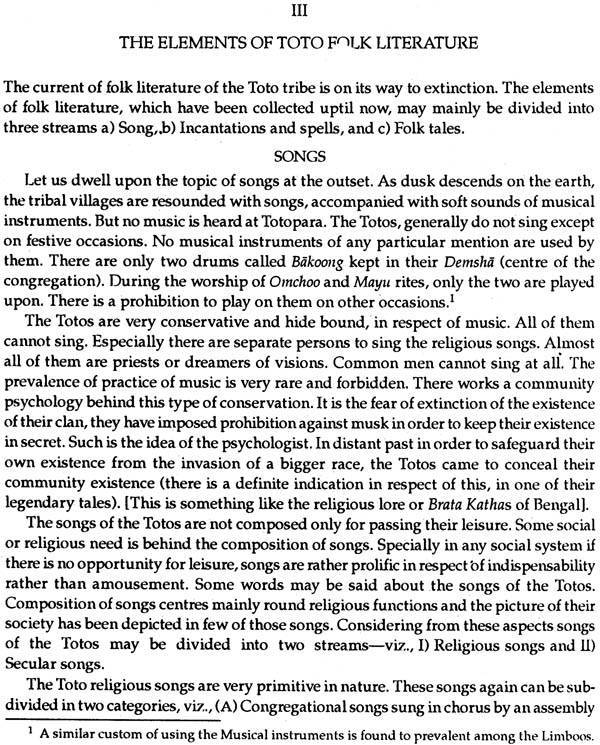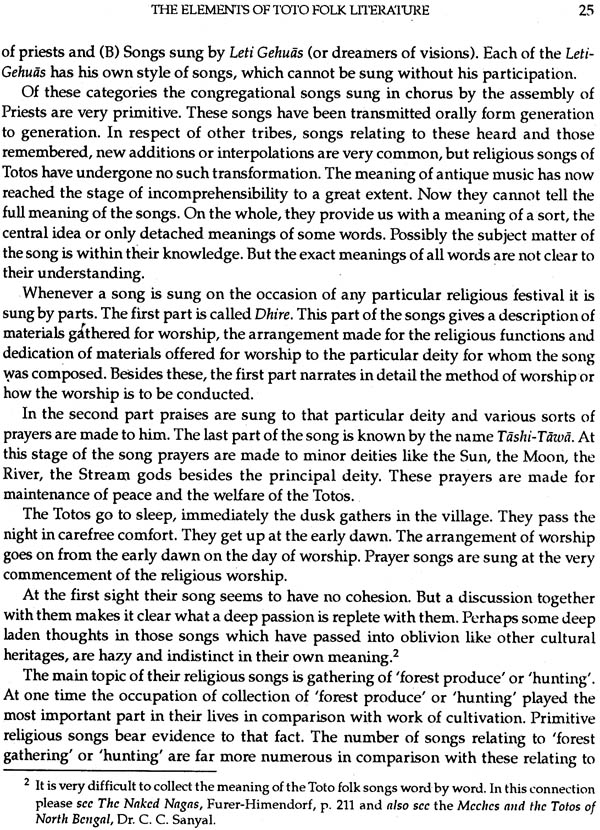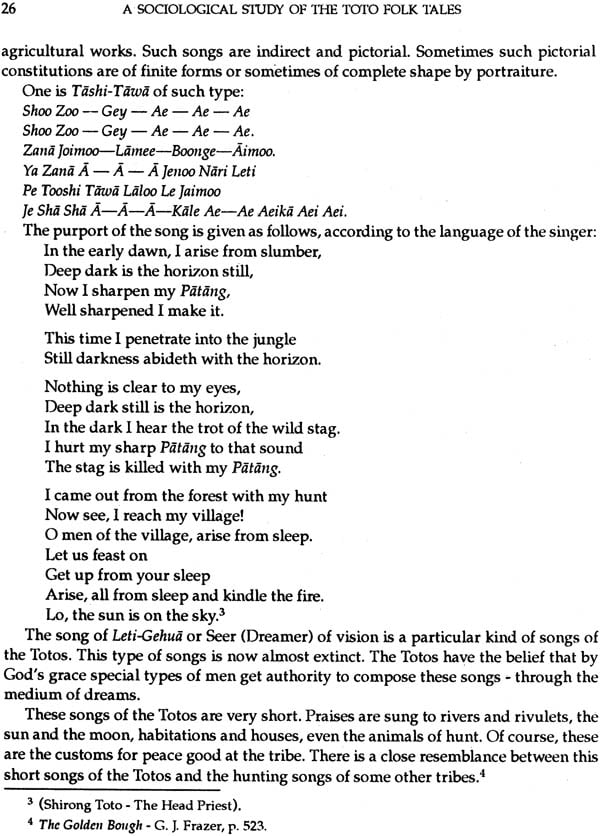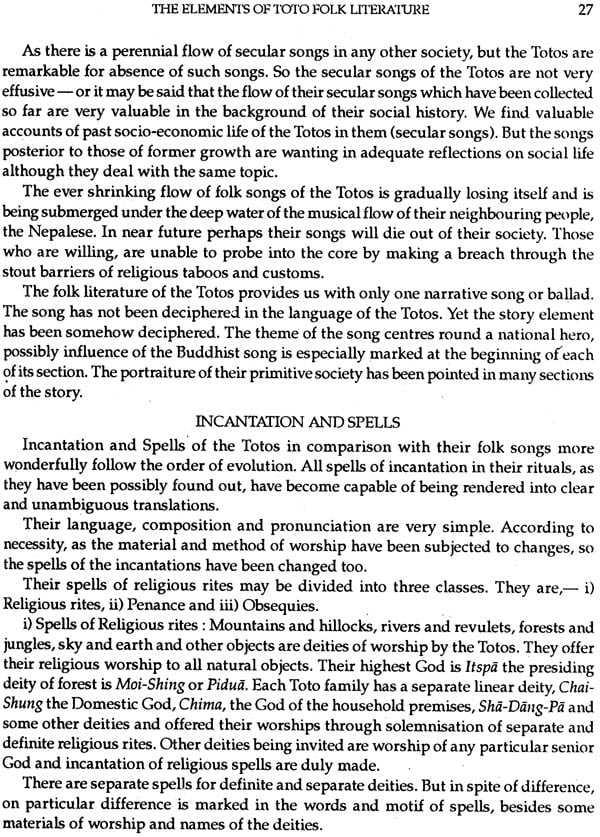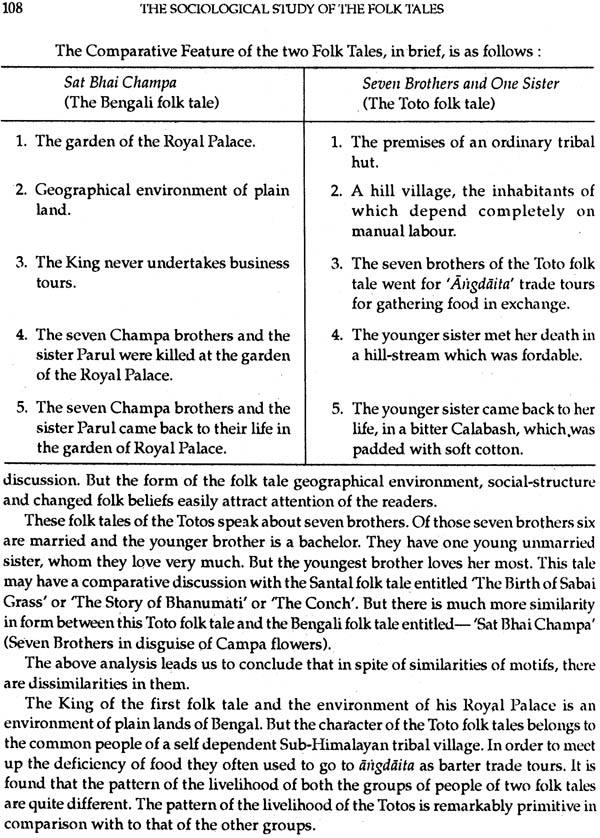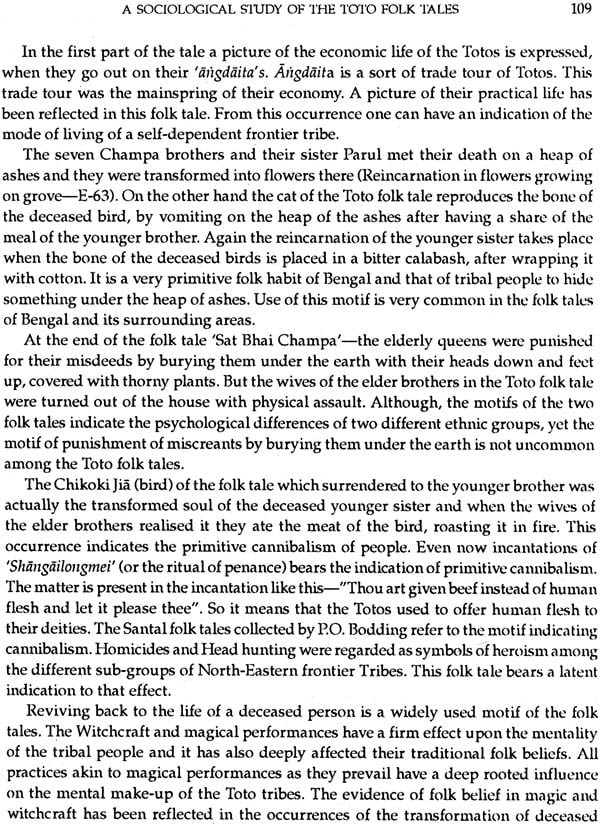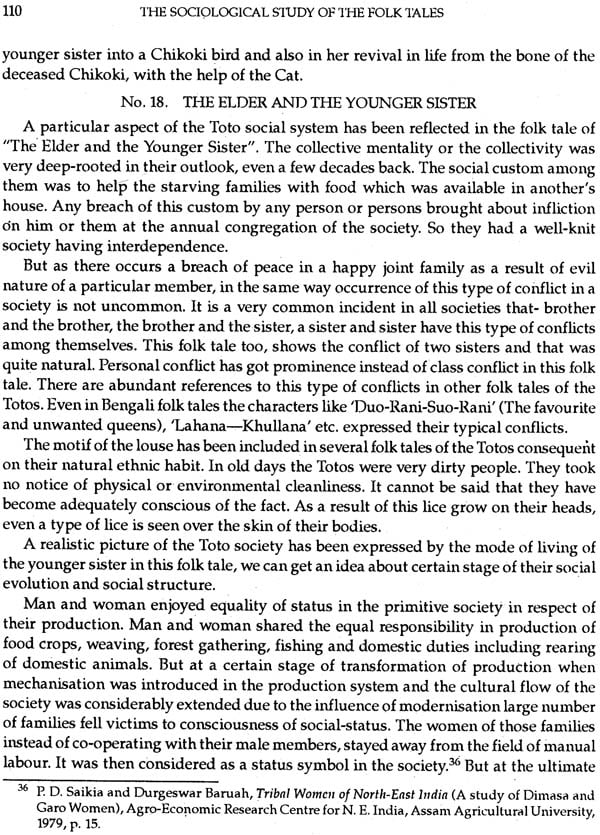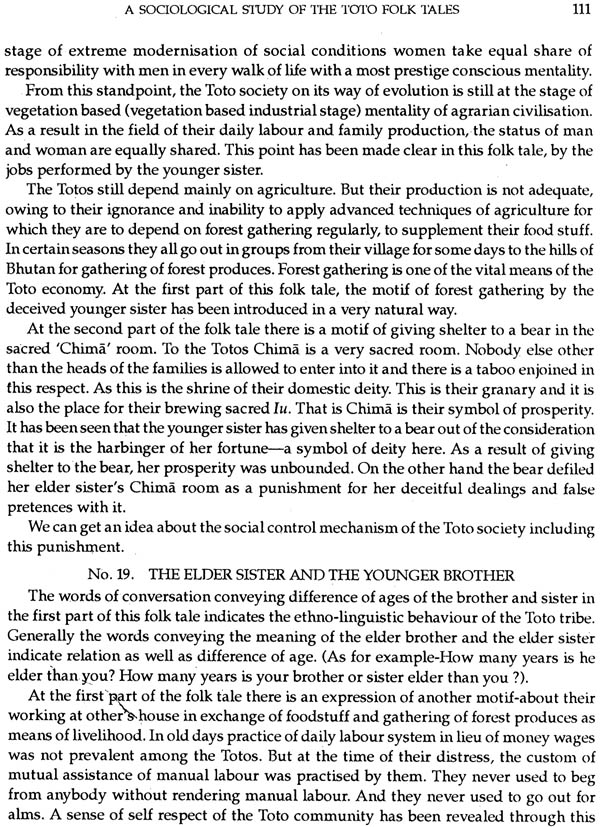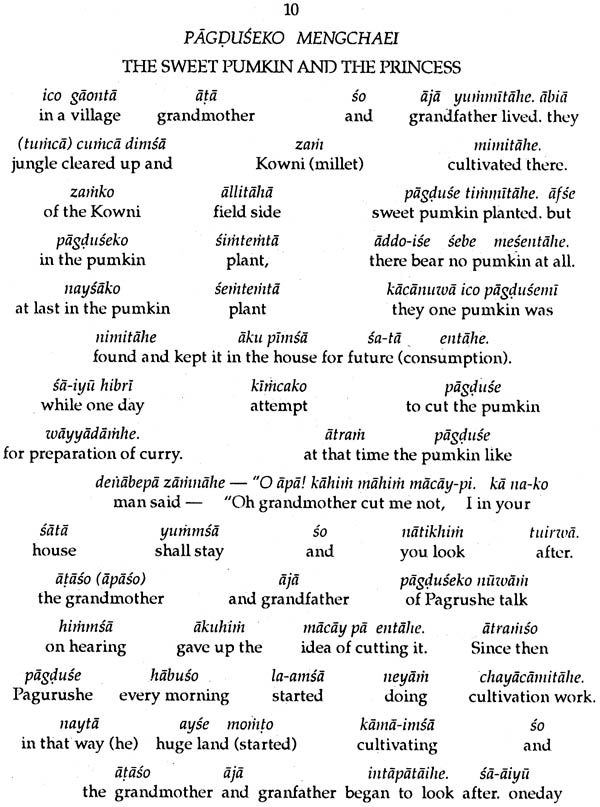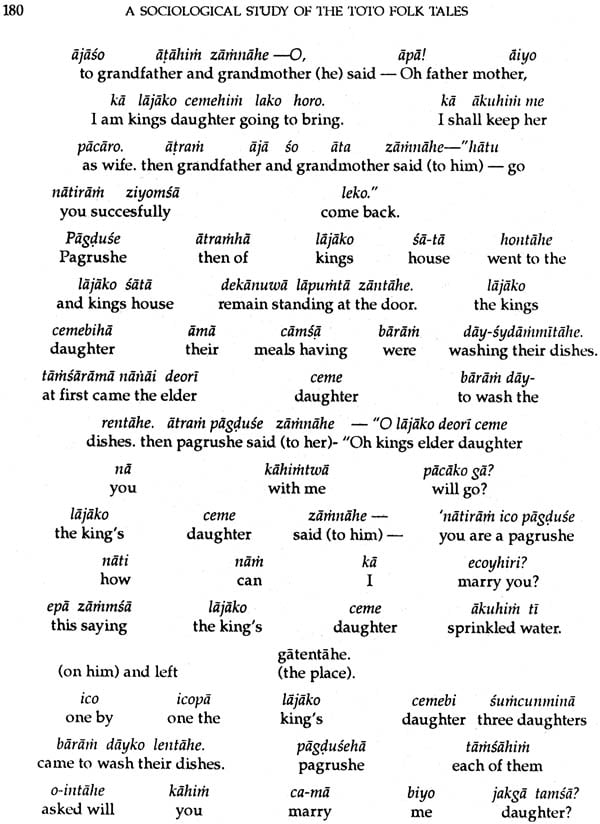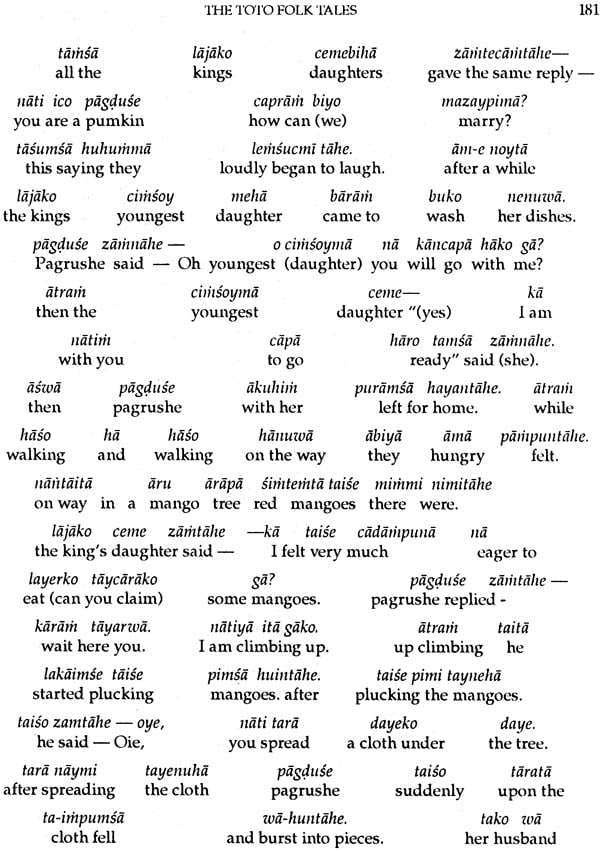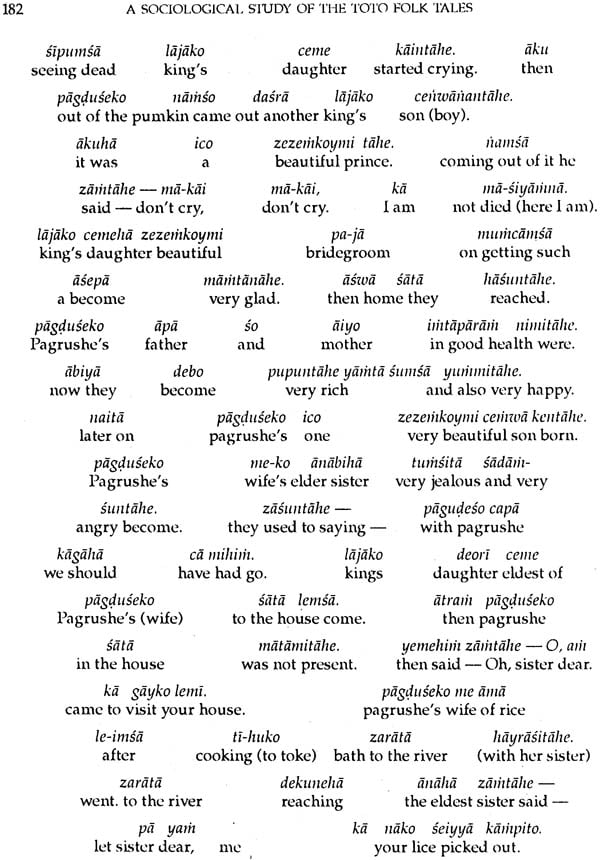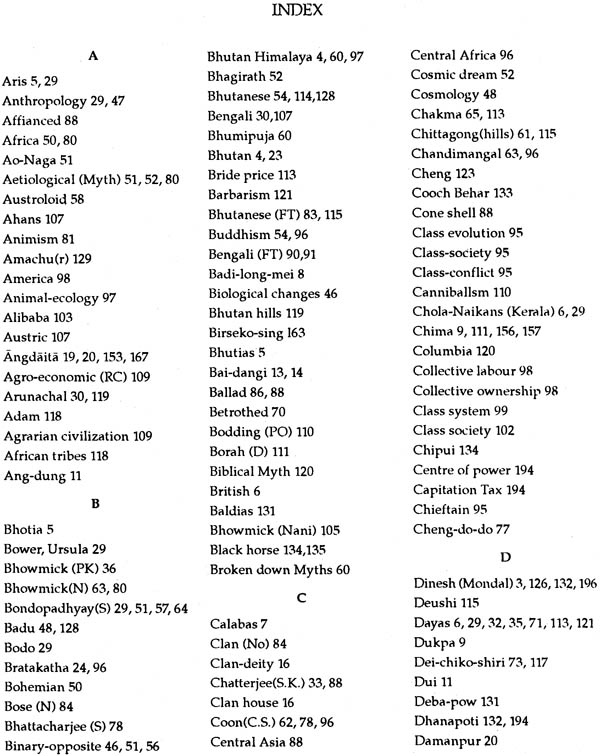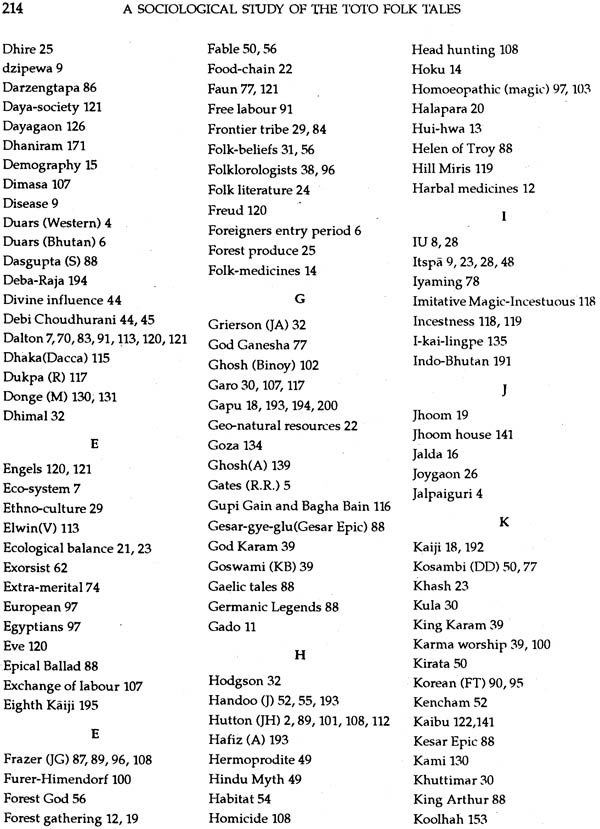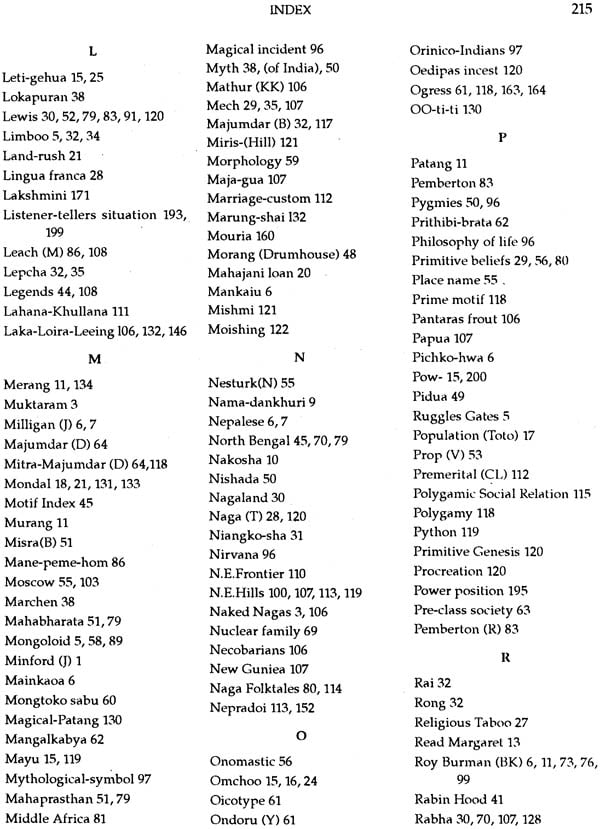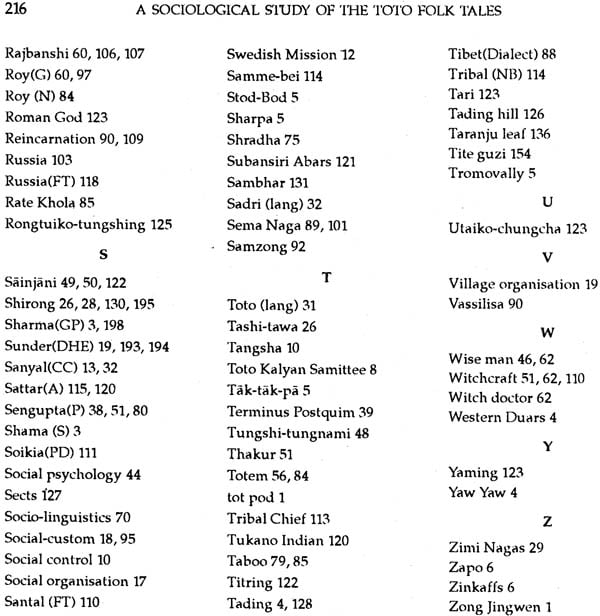
A Sociological Study of the Toto Folk Tales
Book Specification
| Item Code: | NAG552 |
| Author: | Bimalendu Majumdar |
| Publisher: | THE ASIATIC SOCIETY |
| Language: | English |
| Edition: | 2013 |
| ISBN: | 9789381574096 |
| Pages: | 230 |
| Cover: | Hardcover |
| Other Details | 9.5 inch X 7 inch |
| Weight | 620 gm |
Book Description
About the Book
The village Totopara and the Totos - 'Primitive Tribal Group'- underwent tremendous changes due to their close contact with the outer world and exotic communities. Their oral traditions, especially the folk tales, have almost been extinct due to the absence of the traditional 'tale-tellers'. Twenty-four folk tales of the Totos were painstakingly collected by the author and those are presented in the book including five tales in Toto language with English rendering. Shri Bimalendu Majumdar, a devoted folklorist, has analysed the reflections of all the aspects of their oral tradition, particularly the folk tales, upon the plinth of sociological information. The stories have been dealt with to exhibit a convincing image of the traditional culture and society of the entire community. This edition has been thoroughly updated and enlarged.
About the Author
Shri Bimalendu Majumdar (b. 1939) is an independent researcher in folklore. He has done his M.A. and Ph.D from the University of North Bengal. His Ph.D thesis The Totos (cultural and economic transformation of a small tribe in the sub-Himalayan Bengal) was published in 1998. He was awarded, among others, Acharya Dinesh Chandra Sen Smarak Puraskar from Rabindrabharati University for his lifetime achievement in folklore. He has, to his credit, research articles published in different journals and a number of Bengali books.
Prologue
Shri Bimalendu Majumdar is a devoted folklorist as I know him for last twenty-five years or so, and always found him deeply engrossed with the life and lore of the people belonging to lower depths of the socio-economic edifice, particularly in the northern districts of West Bengal. He has spent a sizable period of his life in search of the social, economic as well as cultural nuances of the lives of the Totos, the smallest indigenous group of West Bengal. Smallest, but culturally they are quite rich, as that will be evident from the observations incorporated in the corpus of this quite thought-provoking book by Shri Majumdar. The traditional stories of this particular ethnic group would bear this statement out and also attest the point forwarded by him.
Shri Majumdar's research about the Totes is fully authentic and his command over their language has helped him much in this regard. The previous edition of this book was published more than two decades back and has long been exhausted from the reach of the scholars. This revised edition has been sizably enlarged and neatly updated as far as possible and now is ready for the perusal of the sociologists, ethnologists, culturologists, folklorists and general readers at large.
The most valuable aspect of 'this edition is its updating - not only with the contemporary data collected from the census reports and other official documents, but also with latest researches in the disciplines that are related to this aspect. Shri Majumdars deep insight into the social and economic strata of the Toto people has consequently probed into their cultural psyche. Their deities and rituals, orature and several genres of performing arts, life-cycle and social organisation. Shri Majumdar has analysed the reflections of all of these aspects in their oral tradition, particularly the folk tales, upon the plinth of such sociological information. Majumdar has inquired about the elements of folk orature as a whole of the Totes and subsequently classified their traditional narrative.
The 24 stories, that have been collected and dealt with in this book, exhibit a convincing image of the traditional culture and society of the entire community. Majumdar should be thanked for this absorbing selection. Both social and their underlying folkloristic elements have been skilfully picked, arranged and analysed with required precision. Thus, their society and family structures, along with moral, aesthetic and economic moorings of the Toto people have been neatly portrayed by him. Side by side, the technical folkloric aspects of these stories have been prompted with scholarly skill. The myths of the Totos, their legends and Tales - all have been discussed in the light of the established formulae of the folk-narratives' analytical processes. At the same time, the types, motifs and motifems of the stories, their morphic and structural aspects and finally the historical-materialistic perspectives - Majumdar has searched and analysed them all with absolute confidence. His data bases are attested by the people, about whom he has written this interesting book. His informants belong to the Toto community itself and thus the authenticity of his points are well-established without any doubt.
Books of this kind, surely increase the solidarity among the different communities of the total social polity of the country. Particularly, many indigenous people like the Totos who often are made to feel that they are but mere marginal in the socio-cultural edifice, could be reassured that they rightfully belong to the mainstream of Indian nation. Majumdar has often compared the contents and messages of the Toto narratives with the Bengali tales of similar genres and thereby, the inseparability, inspire of the uniqueness, of the different sectors of-the people has been distinctly drawn. Majumdar must be praised for this.
The new edition of a well-reputed research-treatise now comes to light with the hope that it would serve manifold purposes. Inspite of his falling health, Shri Majumdar has done this difficult task quite creditably. We offer him our heartfelt thanks for this endeavour.
Foreword
The present volume is the second edition of the book entitled A Sociological Study of the Toto Folk Tales" by Bimalendu Majumdar first published by the Asiatic Society in 1991. The author is a 'devoted folklorist' and 'has spent a sizable period of his life in the northern districts of West Bengal.' The second edition has been thoroughly updated and enlarged by him.
The author has painstakingly collected 24 Toto folk tales along with five Toto folk tales in Toto language. Apart from introduction, in five other scholarly chapters he has thoroughly discussed about the background of the Toto tribe, elements of Toto folk literature, classification of Toto folk tales, social analysis of folk tales and sociological study of folk tales. The author rightly deserves our whole hearted praise for such deep and scholarly studies on a community living in a far off remote place in the Sub- Himalayan Indo-Bhutan border of the country.
I hope in view of many problems of the minority ethnic communities of the country the book will be very useful not only lo scholars and researchers in the field but also to planners of the country.
Preface
The folk tales of the Totos were collected about three decades back (1976-80) and released as a 'Monograph Series XXIX' entitled 'A Sociological Study of the Toto Folk Tales' by the Asiatic Society, Kolkata, in 1991. Since then, with the lapse of time the village Totopara and this 'Primitive Tribal Group' underwent tremendous changes due to their close contact with the outer world and exotic communities. As a result, the oral traditions of the Totos, especially the folk tales have almost been extinct owing to the absence of the traditional 'Tale-tellers'. In this context, the author is grateful to the authorities of the Asiatic Society for taking further effort for publishing the second edition of the book with a few additions and alterations and also for preserving those folk tales from extinction.
The author expresses his grateful thanks to Professor Pallab Sengupta, President, The Asiatic Society and Professor Mihir Kumar Chakrabarti, Ceneral Secretary for taking keen interest for bringing out the second revised edition within a very short time. The author is also grateful to Professor Sengupta for his valuable Prologue.
The author is indebted to Sri D. P. Jana, LAS. (Rtd.), who helped him in number of trips not only to Totopara, but also during the former visits to several other tribal villages.
The author expresses his thanks to Prof. G. N. Roy, Dept. of English, University of North Bengal, Prof. Subhash Karmakar and Sri Subrata Sanyal, Chartered Engineer for extending their help and cooperation.
The author is grateful to Shri Nirbed Ray, Publication Officer and other officials of the Publication Section of the Asiatic Society for taking great care throughout the process of publishing the second edition of this book.
Sri Biswapriya Routh, eminent photo-artist of North Bengal also deserves his thank, who contribute some of the photographs for this edition. Sri Rajen Gupta also deserves thanks in this connection.
The author is thankful to his brother Sri Shyamalendu Majumdar and his wife Smt. Rina Majumdar, for their cooperation and suggestions during preparation of the book. The author expresses his thanks to Dr. Cananath Dasgupta and Smt. Soumana Dasgupta, his son-in-law and daughter and also to Sml. Twisha Dasgupta and Sri Hindol Dasgupta, his grand daughter and grandson for their help in preparing the revised edition of this book.
The author once again expresses his gratitude to his wife Smt. Reba Majumdar for extending her sincere help and cooperation during preparation of several books throughout his life.
Introduction
India is a vast country with a population of hundreds of different communities. Some of these communities are advanced and some of them are still backward, and leading their life in a primitive style. These backward communities have been identified as Scheduled Tribes or Tribal people by the British rulers.
Most of the tribal people of India are still settled in the far off places, secluded from the main communication centres and hence cut off from the main cultural stream of the country. So the structure of the tribal societies is still very primitive in comparison to the advanced communities.
Still they are the creators of a certain type of folk culture of their own, which are like the unknown flowers glittering in the lap of wild nature, apparently isolated from the civilised world. But these small creations of the isolated groups of tribal people are also the part of the world of folk culture as a whole (Zhong Jingwen 1983). Like the small rivulets, the songs, myths, legends, folk tales and other oral narratives of the tribal people have contributed to a considerable extent to enrich the treasure of our national folk culture.
The small self-isolated communities like the Totos, who had lost their link with their main ethnic group and emerged as a contact group, in a secluded place of North Bengal, might have lost their separate identity. But as a matter of fact, the Totos not only have retained their separate identity, they also have preserved their tradition of folk literature. On the other hand they also incorporate some elements of folk literature from their neighbouring culture, at the time of their migration and trade tour. And they transformed these elements according to their own design. The elements of Toto folk literature are small as population is being depleted owing to some socio-economic and cultural crisis. Between the third and the fifth decades of this century, the Totos had to pass through a critical time, while their very existence was in question. The .orange cultivation, which was their principal means of livelihood, was destroyed. As a result, they were threatened by poverty and starvation, causing high rates of mortality. But with the help of the neighbouring communities and favourable geographical environments they were able to save their existence from that dangerous crisis. Since then their population has increased with their shifting of the means of subsistence, from orange cultivation to whole time agricultural production and trade tour.
Though they were able to retain their ethnic existence, they could not preserve the sum total of their traditional folk culture. Because some of the elements of their folk literature passed away with the death of their elderly people, who were the main traditional folk artists or taletellers, during that socio-economic crisis. Secondly, a large number of Nepalese have settled at Totopara, for the last three decades. So within a couple of years the Nepali culture has deeply affected the. Toto culture as a whole. As a result, the element of Toto folk literature which has been collected so far, may not appear to be a large one in comparison to the folk literature of the other tribal communities. In fact, owing to the conservative mentality of the Totos, they are not much interested in disclosing any thing about their folk literature to an outsider. Earlier at least two famous anthropologists Dr. C. C. Sanyal and Dr. B. K. Roy Burman tried to collect the folk tales and songs of the Totos, but almost failed. Because till then the Totos were very shy to speak to any outsider. While narrating about the Toto folk literature, Dr. B. K. Roy Burman states that "Totes are peculiarly shy of their myths and lores and songs. Whenever they are asked about these things they were perceptibly embarrassed.
Dr. C. C. Sanyal also narrates - "The Totos do not allow any non-Toto to hear these songs nor they allow any non-Toto to know the correct sense of the song. If asked they give a perverted meaning so that nobody gets interest in the song.
The same experience was expressed by J. H. Hutton -and Furer-Haimendorf in their books about the Naga tribes.
In fact, the Totos are still maintaining the same mentality about narrating their folk literature; they do not want to disclose the exact meaning of the same, except uttering a few words. In this regard it has been found that, they lay more emphasis on their religious folk songs than on their incantations. They disclosed the meanings of their incantations to the writer very easily, but they did not respond equally warmly about some of their religious songs, stating the teason that the meanings of these songs are not known to them, which they claim to have been inherited from their ancestors from the remote past. Now-a-days the Totos do not maintain so much reserve about their folk tales, but they are not experts in this trait of oral narratives and the number of tale- tellers are small among them at present.
Possible precautions and systematic measures have been taken at the time of collection of these folk tales. Totos are of a very restless mentality. They do not sit at a place, at a stretch even for one hour, without drinking III (liquor) and chewing betel leaves. At the time of the collection of folk tales the author had to face a lot of troubles. But after a couple of visits he could win their confidence. Since then he was cordially received by the Totos. A natural relation of friendship has grown up with their headman the Late Dinesh Toto. He helped the author in collecting folk tales. He himself contributed some folk tales to this collection. The man who really introduced me with the Totos is Sri Gharma Prashad Sharma-dedicated social worker of Totopara Tribal Welfare Centre. He helped me through the tenure of my collection of folk tales. He introduced me with my major contributor Sri Rat'ney Toto and other contributors like Sri Muktaram Toto, Sri Shi rong Kaiji etc.
At the time of collecting and compiling the Toto folk tales the author tried to retain the originality of the folk tales i.e. the language, the mode of presentation etc. in most of the cases, the folk tales which were narrated in Toto language, have been translated mainly with the help of Sri Muktaram Toto. In case of some folk tales the teller himself gave the translation of the tale into Nepali language. Only a few folk tales told by Late Dinesh Mondol (Toto) in Toto and Nepali language.
For this reason one may find inconsistency in some of the folk tales, which in fact, is the result of the inconsistency of the taleteller or the fault of his mode of translation. Because the exact Nepali word for the Toto word was not clear to the teller and the ambiguity which existed in himself.
Collection of folk tales is not an easy task in the poverty stricken villages of India, specially inhabited by the small and isolated tribes like the Totos, who are very poor and unacquainted with modern ways of livelihood, and have to work hard from dawn to dusk, almost throughout the year. Yet they fail to gather sufficient food and enjoy other amenities, with their limited means, ideas and age old technical resources. They had to live under the threat of constant danger of being destroyed by hunger and disease.
As such, whenever the author engaged them in orating any folk song or tale, they were gratified with any presentation, in cash or kind, except some rare persons like Late Dinesh Mondol and Muktaram Toto. But most of them prefer country liquor and "Bidi" as their honorarium. A small information about the respondents or taletellers is stated in the book, which will provide an idea about them.
Contents
| Prologue | ||
| Foreword | ||
| Preface (Second Edition) | ||
| Preface (First Edition) | ||
| Chapter I | Introduction | 1 |
| Chapter II | Background Information about the Toto Tribe | 4 |
| Chapter III | The Elements of Toto Folk Literature | 24 |
| Chapter IV | Classification of Toto Folk Tales 38 Myths and Mythical Beliefs of the Totos, Myths Related to | |
| Chapter V | The Social Analysis and the Folk Tales | 69 |
| Chapter VI | The Sociological Study of the Folk Tales | 77 |
| Chapter VII | The Toto Folk Tales | 122 |
| The Bio-Data of the Taletellers mid the Listener-Teller Situation | 193 | |
| Appendix-A | Totopara at a Glance | 203 |
| Appendix-B | Tire Sub-divisions of the Village Totopara, which were utilised by Different Clans | 204 |
| Appendix-C | Census | 205 |
| Appendix-D | Village Organisation in Totopara | 206 |
| Appendix-E | 207 | |
| Bibliography | 209 | |
| Index | 213 | |
| Illustrations | 0 |
